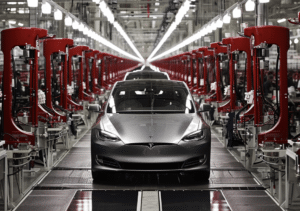Introduction – Tesla’s Engine-less Design
Tesla Incorporated is not just reshaping the automotive industry; it’s revolutionizing the way we think about sustainable transportation. Ditching the traditional gasoline engine, Tesla has introduced a groundbreaking electric powertrain, marking a significant departure from conventional automotive norms. In fact, Tesla does not have a traditional engine. This article delves into the heart of Tesla’s innovation—their unique electric powertrain—and explores how it’s a game-changer in driving sustainable automotive solutions.

What Makes Tesla’s Engine Unique
Compared to conventional automotive manufacturers, such as Ford or Chevrolet, Tesla’s electric vehicle technology brings a fresh approach to vehicle power. Instead of a combustion engine, Tesla vehicles operate with an electric powertrain, a system involving an electric motor and a large lithium-ion battery pack.
Does Tesla Have an Engine?
In a surprising revelation, Tesla does not employ a traditional ‘engine’ as seen in gasoline or diesel-run vehicles. Rather, the backbone of a Tesla vehicle is its revolutionary, eco-friendly powertrain. This system is significantly smaller, more efficient, and less complex than the conventional machinery found in a traditional vehicle’s internal combustion engine.
How Does Tesla’s Powertrain Work?
In contrast to an engine in a conventional car, a Tesla vehicle utilizes an innovative powertrain that consists of an electric motor and a battery pack. The stored energy in the battery pack is converted into mechanical power by the electric motor, driving the vehicle’s wheels.
The execution of this process is not only proficient but also provides a quiet, seamless, and immediate response, adding to Tesla’s reputation for impressive acceleration and performance.
4 Benefits of Tesla’s Unique Power System
Tesla’s electric motor, a cornerstone of its engineless design, represents a significant leap in automotive engineering and design. Unlike the complexity of traditional internal combustion engines, Tesla’s electric motor is lauded for its simplicity and minimalistic design, featuring far fewer moving parts.
This streamlined construction not only contributes to the motor’s robustness and reliability but also significantly enhances its efficiency. A notable innovation in this area is the use of a single-speed transmission, which contrasts sharply with the multi-gear setup in conventional engines.
This simplicity translates to lower maintenance requirements and improved durability. Furthermore, Tesla’s electric motor offers exceptional performance benefits. It delivers instant torque, enabling rapid acceleration from a standstill—a feature that internal combustion engines cannot match due to their need for revving up.
This instant power delivery, combined with the motor’s high efficiency, results in a driving experience that is not only exhilarating but also smoother and more responsive. These technological advancements underscore Tesla’s pioneering role in redefining the fundamental mechanics of automobile propulsion, moving away from traditional engines towards a more efficient, powerful, and sustainable electric motor design.
Contribution of Tesla’s Design Towards Carbon Reduction and Sustainability
Tesla’s approach to sustainability extends far beyond just zero tailpipe emissions. A critical aspect of their environmental contribution lies in the entire life cycle of their vehicles, including battery production and the source of electricity used for charging.
While it’s true that the manufacturing of electric vehicles, particularly the lithium-ion batteries, has its environmental costs, Tesla is continually innovating in this area. They are investing in more efficient production methods and working towards sustainable battery materials sourcing and recycling.

This holistic view of sustainability is crucial, as it encompasses not only the operation of the vehicle but also its production and end-of-life stages. Additionally, the impact of a Tesla vehicle on the environment is significantly influenced by the electricity’s source; when charged with renewable energy, the environmental benefits are maximized, further reducing the overall carbon footprint.
Moreover, Tesla’s advancements in battery technology play a pivotal role in their sustainability narrative. Their continuous improvements in battery efficiency and lifespan mean that Tesla vehicles can travel longer distances on a single charge, reducing the frequency of charging and the associated energy use.
This, coupled with the potential for battery recycling, mitigates the environmental impact of used batteries. Importantly, Tesla’s ecosystem extends to solar energy solutions, like SolarRoof and Powerwall, which enable vehicle charging with solar power, creating a seamless renewable energy loop.
The global impact of Tesla’s approach is substantial; though specific statistics vary, the shift from gasoline to electric vehicles, as championed by Tesla, is estimated to significantly reduce carbon emissions, contributing to a marked decrease in transportation-related environmental impact.
This broader perspective of Tesla’s contribution illustrates the company’s commitment to not just advancing automotive technology, but also fostering a more sustainable and environmentally responsible future.
Frequently Asked Questions About Tesla Vehicles
When discussing Tesla, many common queries arise – “How does Tesla reach such high speeds without an engine?” To answer this, one needs to understand the Tesla’s almost instantaneous electric powertrain.
Upon receiving power from the battery, the motor can initiate an immediate response, reducing lag and providing superior acceleration compared to traditional combustion engines. Another frequently asked question is “Can a Tesla car be charged at home?”
The answer is definitely yes – Tesla offers convenient charging solutions for home setup to ensure your vehicle is always ready for the road.
Tesla Inc. – From Electric Cars to Full Energy Solutions
Tesla, Inc., with a little more than a decade in vehicle manufacturing, continues to lead the electric vehicle market with cutting-edge design, sustainable energy solutions, and superior performance. With vehicles like the Model S and Model 3, Tesla has brought performance electric vehicles into the mainstream.
Beyond electric cars, Tesla’s contributions to renewable energy resources, like their Powerwall and SolarRoof, are equally impressive. However, Tesla needs to address challenges in the areas of customer service and delivery logistics.
Nonetheless, Tesla’s mission to push the world towards a sustainable future seems more achievable than ever before.
Conclusion – Tesla’s Engine
In summary, Tesla’s unique, engine-less design is transforming our understanding of what makes a vehicle “run.” By replacing traditional engines with an efficient powertrain system, Tesla is propelling the future of the automotive industry towards greener and more sustainable options. More than just a manufacturer of vehicles, Tesla is at the forefront of a comprehensive approach to sustainable living
